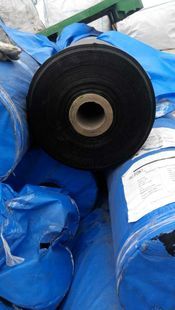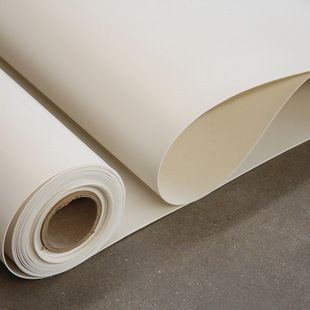There are three types of common construction technologies for coil waterproofing construction: 1. Three methods: thermal construction process 2, cold construction process and mechanical fixation process. There are four methods for paving, including four methods: full-stick method, empty-padding method, stick-adhesion method, and point-adhesion method.
During construction, appropriate construction methods should be selected according to different design requirements, materials, and project specific conditions.
1, thermal construction process method is divided into three different situations: 
(1) Hot Mastic Adhesion
Its practice is that the traditional construction method is to roll the hot mastic grease while rolling the linoleum and spread it layer by layer. Appropriate range: petroleum asphalt tarpaulin three felt four oil (two felt three oil) laminated paving.
(2) hot melt method
Its practice is to use a flame heater to melt the hot melt adhesive at the bottom of the hot-melt type waterproof membrane and paste it. Scope of application: thermoplastic synthetic polymer waterproof membrane lap seam welding.
(3) hot air welding:
The common method is: using a hot air welding torch to heat the lap joints of the waterproofing material to perform lap joints for bonding. Scope of application: thermoplastic synthetic polymer waterproofing membrane lap seam welding.
2. The cold construction method also includes three different methods.

(1) Cold mastic paste method
Its practice is to use factory-prepared cold asphalt cement materials without applying heat during the construction. Apply the felt directly after scraping. Scope of application: Petroleum asphalt felt three felt four oil (two felt three oil) laminated paving.
(2) Cold bonding method
Its practice is to use adhesives to bond the web with the substrate, web, and web without heating. Scope of application: Synthetic polymer membrane, polymer modified asphalt waterproof membrane.
(3) Self-adhesive method
Its approach is to use a waterproof membrane with self-adhesive, without thermal construction, without the need to brush the glue material, direct bonding. Scope of application: Synthetic polymer waterproof membrane with self-adhesive and polymer modified asphalt waterproof membrane.
There are also two different situations in the mechanical fixation method.

(1) Mechanical nailing method
Its practice is to use galvanized steel or copper nails and other fixed coil waterproof layer. Scope of application: It is mostly used for the laying of polymer modified bitumen membranes in wood base layers.
(2) Pressure embedment method
Its practice is that most of the coiled material is not bonded to the grass-roots, and it is buryed with pebbles etc., but the lap joints and all around are sticky. The scope of application for empty shop law, inverted housing.
Roll waterproofing method and advantages and disadvantages.
1, full paste method, also known as full-stick method, is a traditional construction method, hot melt, cold sticking, self-adhesive method can use this method. Its advantages and disadvantages are: When used in three-felt four oil bitumen waterproofing membranes, each layer has a certain thickness of mastic asphalt is full, can improve the waterproof performance. However, if the humidity leveling layer is large or the surface deformation is large, the waterproof layer is susceptible to cracking and cracking. Applicable conditions: The roof area is small, the roof structure is less deformed, and the leveling layer is dry.
2, empty shop
Its practice is that the web and substrate are pasted only within a certain width, and the rest are not pasted. When paving, the joints of the roof protruding from the corners of the cornices, ridges and floors shall be prominent. The coils and screeds shall be full of stickiness. The width of the adhesive shall not be less than 80mm. The lap joints of the coils and coils shall be full of stickiness, and shall be laminated. At the time, the web and the web should be full. Its advantages and disadvantages: It can reduce the influence of the deformation of the base layer on the waterproof layer, and it is helpful to solve the problem of wrinkling and cracking of the waterproof layer. However, since the waterproof layer is not adhered to the base layer, once it leaks, the water will turbulent under the waterproof layer and it is not easy to find the leak.
3, sticking method
Its practice is that the coils and the grass-roots level using a sticky bond, each roll and the grass-roots level of the surface is not less than two, each width of not less than 150mm, coil and coil overlap should be sticky, laminated shop also Should be full of sticky, its advantages and disadvantages: As the part of the membrane and the basehouse do not stick, it increases the deformation capacity of the waterproof layer to adapt to the grass-roots level, which is conducive to preventing the drum from cracking and cracking. The disadvantage is that the operation is more complicated, in some places can reduce an oil, affecting the waterproof function.
4, point and stick method
Its approach is to use a point bonding between the coil and the base layer, requiring at least 5 bonding points per square meter, with an area of ​​not less than 100mm × 100mm per area. The overlapping area of ​​the coiled material should be fully viscous, and the surrounding area of ​​the waterproof layer should also be consistent with the base layer. Fully sticky. When the first layer uses a punch, it is also a point bond. The disadvantages are: the ability of the waterproof layer to adapt to deformation of the base layer is increased, and the problem of wrinkling and cracking of the waterproof layer is solved. When the first layer is made of perforated coils, it can only be used for multi-laminate construction of coils and the operation is complicated.